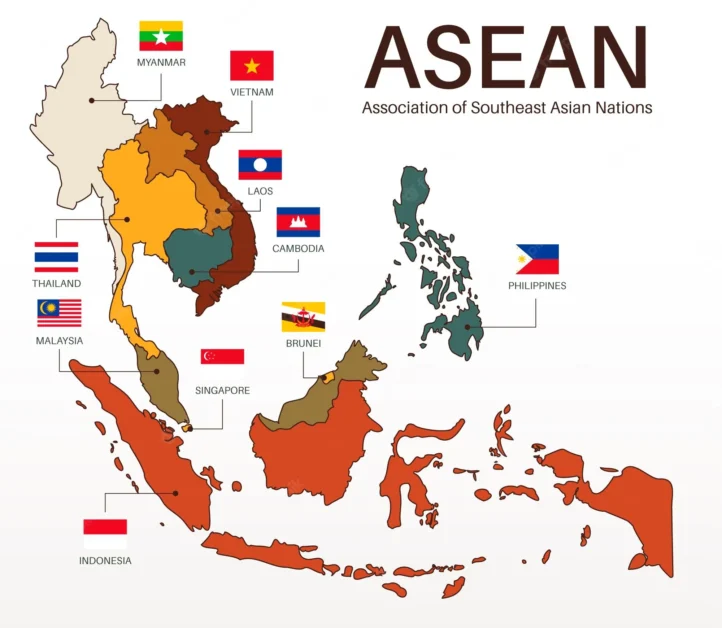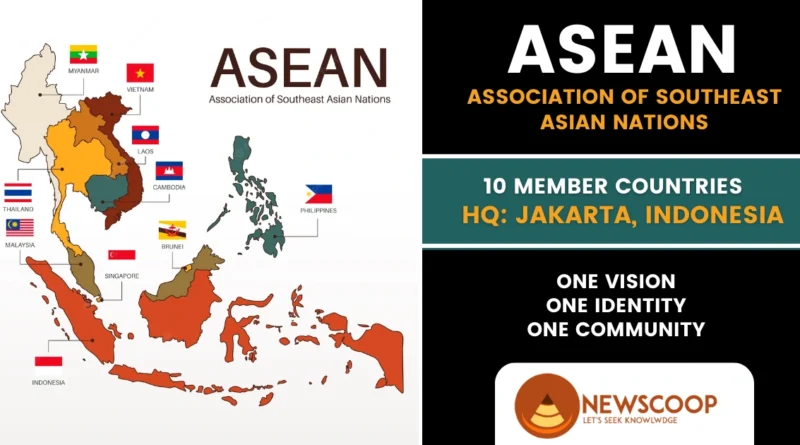ASEAN: Headquarters, Members, Objectives & Evolution
The Association of Southeast Asian Nations (ASEAN) holds a significant position in the geopolitical landscape of Southeast Asia. Recognized as a key player in regional integration and cooperation, ASEAN plays a crucial role in shaping the socio-economic and political dynamics of the region.
In this article, we explore the key aspects of ASEAN and its relevance in the context of the Union Public Service Commission (UPSC) examination.
Association of Southeast Asian Nations (ASEAN)
ASEAN, the Association of Southeast Asian Nations, is a regional organization comprising ten member countries in Southeast Asia. Established in 1967, ASEAN aims to promote economic growth, regional stability, and cooperation among its members. Moreover, it fosters economic integration through the ASEAN Economic Community, enhances political and security cooperation, promotes socio-cultural collaboration, and engages in external relations with global partners.
Motto: “One Vision, One Identity, One Community”
Members Countries of ASEAN
The Association of Southeast Asian Nations (ASEAN) has ten member countries. Here is the list of ASEAN member countries:
- Brunei Darussalam
- Cambodia
- Indonesia
- Laos
- Malaysia
- Myanmar
- Philippines
- Singapore
- Thailand
- Vietnam
Members on Map

Headquarters
The headquarters of the Association of Southeast Asian Nations (ASEAN) is located in Jakarta, Indonesia.

Evolution of ASEAN
The establishment of ASEAN, the Association of Southeast Asian Nations, can be traced back to the desire for regional cooperation and stability in Southeast Asia during the 1960s. At the time, the region faced various challenges such as the threat of communism, conflicts, and political tensions. The founding members recognized the need for a united front and cooperation to address these issues effectively.
On August 8, 1967, the five founding member countries, namely Indonesia, Malaysia, Philippines, Singapore, and Thailand signed the Bangkok Declaration, officially establishing ASEAN. The declaration, also known as the ASEAN Declaration, outlined the principles and objectives of the organization.
Founding Members of ASEAN
The founding members of ASEAN, who signed the Bangkok Declaration on August 8, 1967, are:
- Indonesia
- Malaysia
- Philippines
- Singapore
- Thailand
The key principles emphasized in the declaration include:
- Non-Interference: ASEAN members are committed to respecting each other’s sovereignty, territorial integrity, and political independence. They agreed not to interfere in each other’s internal affairs.
- Peaceful Coexistence: The founding members pledged to promote peaceful coexistence and peaceful settlement of disputes. They aimed to resolve conflicts through peaceful means, including negotiation, mediation, and consultation.
- Mutual Respect: ASEAN countries agreed to uphold mutual respect and equality, recognizing the diverse cultures, beliefs, and systems in the region.
- Cooperation: The members are committed to fostering cooperation and collaboration in political, economic, social, and cultural fields.
The establishment of ASEAN provided a platform for member countries to engage in dialogue, build trust, and work towards common goals. Over the years, ASEAN has expanded its membership to include Brunei Darussalam, Cambodia, Laos, Myanmar, and Vietnam. Moreover, the organization has deepened its integration efforts and developed various cooperative mechanisms and frameworks to address regional challenges and promote regional stability and development.
ASEAN Expansion
Here are the other five member countries that joined ASEAN along with respective years:
- Brunei Darussalam (1984)
- Vietnam (1995)
- Laos (1997)
- Myanmar (1997)
- Cambodia (1999)
Objectives of ASEAN
The objectives of ASEAN encompass several key areas:
- Promote economic integration.
- Enhance political and security cooperation.
- Foster socio-cultural collaboration.
- Strengthen regional resilience.
- Enhance connectivity and infrastructure development.
- Promote sustainable development.
- Deepen cooperation in science, technology, and innovation.
- Enhance people-to-people exchanges.
- Foster a rules-based regional order.
- Promote peaceful coexistence among member countries.
ASEAN-led Forums: Promoting Regional Cooperation
ASEAN-led forums are platforms initiated and led by the Association of Southeast Asian Nations (ASEAN) to promote dialogue, cooperation, and collaboration among ASEAN member countries and their partners. Some of the prominent ASEAN-led forums include:
- ASEAN Regional Forum (ARF): The ARF is the primary multilateral security forum in Asia-Pacific, bringing together ASEAN member states and their external partners to discuss political and security issues, including conflict prevention, confidence-building measures, and regional stability.
- East Asia Summit (EAS): The EAS is a forum for leaders of ASEAN member countries and their dialogue partners, which includes major powers in the Asia-Pacific region. It addresses strategic, political, and economic issues and provides a platform for discussing regional security, development, and cooperation.
- ASEAN+3: ASEAN+3 is a cooperative framework between ASEAN and three East Asian countries, namely China, Japan, and South Korea. It aims to enhance economic cooperation, financial stability, and cultural exchanges among the ASEAN member states and these three East Asian partners.
- ASEAN Regional Forum on Malaria (ARF-M): The ARF-M is a forum focused on combating malaria in the ASEAN region. It brings together health experts, researchers, policymakers, and stakeholders to coordinate efforts and share best practices in preventing, controlling, and eliminating malaria.
- ASEAN Ministerial Meeting on Agriculture and Forestry (AMAF): The AMAF is a platform to discuss agricultural and forestry-related issues, including food security, sustainable agriculture, rural development, and environmental conservation.
Also Read: United Nations Human Rights Council
India & ASEAN
India and ASEAN (Association of Southeast Asian Nations) have witnessed a significant transformation in their relations over the years. Initially, due to ideological differences and ASEAN’s alignment with the US during the Cold War, India’s relations with ASEAN did not develop significantly.
However, following the end of the Cold War, both sides recognized the need for closer cooperation to address shared dangers and objectives, leading to the advancement of their relations beyond economic connections to geopolitical heights. Here is a timeline highlighting key milestones in India-ASEAN relations:
- 1996: India joined the ASEAN Regional Forum (ARF), a platform for security dialogue in Asia, enabling members to discuss and collaborate on regional peace and security concerns.
- 2002: Annual summit-level meetings between India and ASEAN commenced, providing a framework for regular high-level engagement and discussions.
- 2009: The India-ASEAN Free Trade Agreement in Goods was concluded, promoting trade and economic integration between India and ASEAN member countries.
- 2012: The India-ASEAN Strategic Partnership was established, emphasizing the strategic importance and deepening of bilateral ties between India and ASEAN.
- 2014: A Free Trade Agreement in Services and Investment between India and ASEAN was signed, aiming to enhance the movement of labor and investments between the two sides.
- 2018: ASEAN and India commemorated their 25th anniversary of partnership with a special summit held in India. The heads of state from all 10 ASEAN nations attended India’s Republic Day parade, symbolizing the strengthening of ties between India and ASEAN.
These milestones reflect the growing cooperation and mutual understanding between India and ASEAN, encompassing not only economic aspects but also security, diplomacy, and people-to-people exchanges. The partnership between India and ASEAN continues to evolve, driven by the shared goals of peace, stability, and prosperity in the region.
Conclusion
In conclusion, India’s relationship with ASEAN has evolved from ideological differences to a strategic partnership. The bilateral ties have expanded beyond economic connections, encompassing security, diplomacy, and people-to-people exchanges.
With the signing of trade agreements and regular high-level engagements, India and ASEAN have strengthened their cooperation, contributing to regional peace, stability, and shared prosperity. The partnership holds immense potential for further collaboration and mutual benefits in the ever-changing geopolitical landscape of Southeast Asia.
Thank You!
How many member countries are there in ASEAN?
ASEAN, the Association of Southeast Asian Nations, consists of 10 member countries. These nations include Brunei Darussalam, Cambodia, Indonesia, Laos, Malaysia, Myanmar, Philippines, Singapore, Thailand, and Vietnam.
When was ASEAN formed?
ASEAN, the Association of Southeast Asian Nations, was formed on August 8, 1967. The formation of ASEAN was marked by the signing of the ASEAN Declaration, also known as the Bangkok Declaration.

